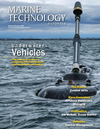
Page 48: of Marine Technology Magazine (January 2024)
Read this page in Pdf, Flash or Html5 edition of January 2024 Marine Technology Magazine
TECH FEATURE NBOSI
SMALL CTD MAKER PACKS
A POWERFUL PUNCH
NBOSI
Neil Brown Ocean Sensors Inc. (NBOSI) has a long history supplying research-quality
Conductivity-Temperature-Depth (CTD) sensors in a compact, cost-effective and easy-to- integrate package for a range of subsea vehicles, including the fast-growing micro AUV market. Dave Fratantoni, CEO, NBOSI, discussed the tech and the market potential.
By Greg Trauthwein
What is NBOSI? number one’ and applied early versions of the NBOSI sen-
NBOSI builds conductivity temperature depth sensors (CTDs) sor technology to my ? eets of Webb Research, now Teledyne for AUVs. Our CTDs are accurate, rugged, and reliable; custom- Slocum, gliders, L3Harris (OceanServer) Iver2 vehicles, and designed for integration with autonomous marine platforms of Liquid Robotics Wave Gliders. all types: AUVs, ASVs, gliders, ROVs, and everything in be- Over those 20 years, NBOSI has maintained a strong rela- tween. As an ocean scientist, I appreciate the value of measuring tionship with both WHOI and another contemporary WHOI temperature and salinity because of their fundamental role in spinoff, Hydroid, which is now part of Huntington Ingalls In- shaping ocean dynamics and in? uencing ecosystems. As an en- dustries. We have been fortunate to equip many variants of gineer and a vehicle operator too, I also understand that accurate the hugely successful REMUS line of AUVs with our sensors. temperature and salinity can yield important information about We expect to sell our 1000th sensor in the ? rst half of 2024. things like ocean density and sound speed, that have direct im- pact on performance. I would argue that measuring temperature There are many CTDs on the market; what makes the and salinity from any platform is a really good idea, but au- NBOSI offering unique?
tonomous mobile platforms in general are almost always power There are a lot of good sensors, and it’s not our goal to com- and size and space limited, and they’re often designed from the pete with all of them. But there are some sensor technologies beginning for challenging missions that emphasize robustness, and their implementations that are simply better suited for cer- reliability and hydrodynamic ef? ciency. Because of that, there’s tain purposes than others. For example, there are some highly really no one off-the-shelf CTD solution that’s going to ? t this re? ned sensors which enable extremely accurate measurement cornucopia of AUV and ASV designs out there. of salinity, and these types of measurements are crucial for un-
The company was spun out of the Woods Hole Oceano- derstanding large-scale ocean dynamics and quantifying cli- graphic Institution in 2003 and was founded by three people: mate variability, especially in the deepest waters. But this accu-
Neil Brown, Dr. Ray Schmitt and Bob Petitt. racy comes at the cost of size and power, fragility of the sensor,
As a WHOI scientist myself 20 years ago, I was ‘customer potentially complex plumbing and the need for constant at-sea 48 January/February 2024
MTR #1 (34-49).indd 48 1/30/2024 6:22:30 PM

 47
47

 49
49
